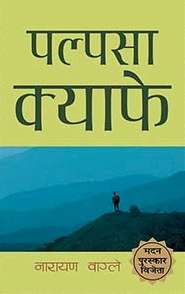Palpasa Cafe
 | |
| Author | Narayan Wagle |
|---|---|
| Original title | पल्पसा क्याफे |
| Translator | Bikash Sangraulaa |
| Country | Nepal |
| Language | Nepali |
| Genre | Novel |
| Publisher | Nepalaya (Kathmandu, Nepal) |
Publication date | 2005 |
| Media type | |
| ISBN | 978-9-93-780210-9 |
Palpasa Cafe (Nepali:पल्पसा क्याफे) is a novel by Nepali author Narayan Wagle. It tells the story of an artist, Drishya, during the height of the Nepalese Civil War. The novel is partly a love story of Drishya and the first generation American Nepali, Palpasa, who has returned to the land of her parents after 9/11. It is often called an anti-war novel, and describes the effects of the civil war on the Nepali countryside that Drishya travels to.[1]
The book has been a best-seller in Nepal, creating a sales record for a Nepali book of 25,000 copies in the first year.[2] It was Wagle's first book. Since its release, the book has received many honours including the highly prestigious literary award in Nepal, the Madan Puraskar.[3] After Palpasa Cafe, Wagle has written another best-selling book, Mayur Times.
The book was written originally in Nepali and was later translated into English and Korean. The book has sold over 52,000 copies as of July 2012. Palpasa Cafe has officially became the first Nepali novel available in Kindle, it also comes in various portable and ebook formats like mobi and pdf.[4]
Plot summary
In the prologue, Wagle tells that he is planning on writing a book inspired by his friend Drishya who gets kidnapped. Drishya’s story begins with his meeting with a Nepalese girl Palpasa who is on a trip in India. They have a number of meetings and there seems to be a spark between them but neither of them pursue on. We then follow Dirshya to Kathmandu. There Drishya has a chance meeting with Palpasa. They kind of start seeing each other but still no one takes things further. After some time he had a fortuitous meeting with Siddhartha, his friend from college, who says that he is Maoist in hiding and asks for shelter. They start talking on the situation of the nation. They both disagree on many points and finally Siddhartha challenges Drishya to visit the ‘world they created’. He accepts and treks the hilly regions under the insurgent control; visiting many villages including the village from where he is and soon finds that his childhood friend had died due to war. Near the end of the journey, Siddhartha gets killed in front of him because he mistakenly points him out to the army. Heavy hearted he is on his way back when he happens to meet Palpasa on the ride back to Kathmandu who is on her way to make documentary on the war. There she gets killed when the bus explodes due to a mine. Drishya survives because he was out of the bus. He returns to Kathmandu and tries to continue with his life. But her death haunts him for a long time and he feels a bit at peace when he completes a series of paintings ‘Palpasa Cafe’. Then later he is kidnapped and his whereabouts is unknown. In the epilogue, Wagle meets with a girl named Gemini who is searching for her lost friend who happens to be Palpasa.
Characters
- Drishya: He is the protagonist of the book. His name literally means 'view'. He is an artist living in Kathmandu, originally from a small village of Nepal. He is also the author of a fictional book that remains unnamed which is Palpasa's favorite book.
- Palpasa: She is the love interest of Drishya. She is a Nepali woman who studied in USA.
- Siddhartha: He is an old friend of Drishya from college. He is a Maoist in hiding and asks Drishya for shelter.
- Christina: She is a Dutch woman who is interested in Drishya. She is the one who tells him that his 'paintings look cold' and also after some time tells him that the reason was the color of the wall in his paintings.
- Narayan Wagle: He is the author of the novel who is also a character in the prologue and epilogue. He is a friend of Drishya.
Style
The novel is written in thirty chapters, including a prologue and an epilogue. The prologue and epilogue are in Narayan Wagle's POV while the rest of the twenty-eight chapters are in Drishya's POV.